Types of Rivet Nails and Their Joining Techniques
As a key connection solution, rivets and their riveting technology play a fundamental and important role in the field of CNC machining. Advanced machining methods such as CNC milling and turning provide solid technical support for the precise manufacturing and efficient production of rivets.
Rivets are favored for their high reliability, strong connection force, long service life and easy operation. They can be flexibly applied to the connection needs of various materials such as aluminum alloy, structural steel and composite materials. Today, China Weimate will take you to explore the types of rivets and their riveting processes.
What are Rivets and How Do They Work?
Rivets are a basic metal product in the form of a rod-shaped structure with a cap at one end. The working principle is that when the rivet is inserted into a hole pre-punched in the connecting material, the rivet is not only highly reliable, has high connection strength, and has a long life, but is also easy to operate and use. It is widely used in various manufacturing fields. By applying pressure or striking at the outer end, the other end is deformed, thereby firmly clamping and fixing these materials.
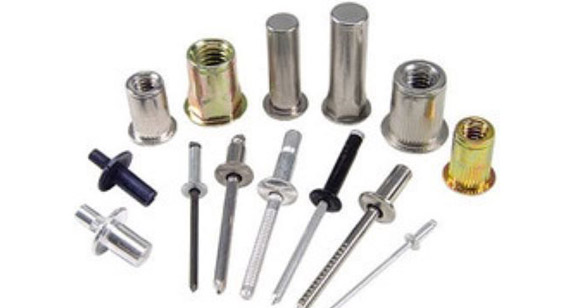
What are the Different Types of Rivets?
Blind rivet: This type of rivet is used to pull the core head from one side through a rivet gun to achieve a tight connection between the two parts. It is particularly suitable for complex structures and scenes where only one-side operation can be performed. Common types include open flat round head and closed countersunk head.
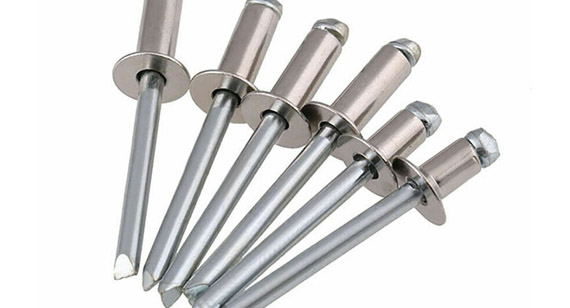
Stamping rivets: Stamping technology is used to make rivets or connecting parts plastically deform after being stressed, thus achieving a firm connection. This method is highly efficient and suitable for environments where both sides can be operated. It is commonly used in metal structures and dissimilar metal connections.
Spin rivets: The rivet is locally pressurized by the rivet rod and continuously swung around the center, including swing riveting and radial riveting, which can achieve high-quality riveting with good stability.
Solid rivets: Due to their solid structure, they have higher shear resistance and are mostly used in metal connections that need to withstand greater shear forces.
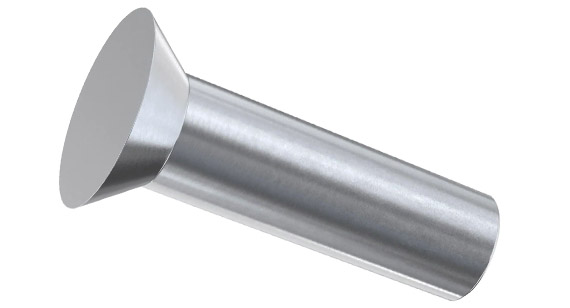
Semi-hollow rivets: Lightweight in design, they can reduce weight while maintaining shear force bearing capacity comparable to solid rivets. They are often used to connect metal sheets to other non-metallic materials.
Open rivets: They are commonly used in home repairs and DIY projects due to their simple design and ease of installation. Their large heads and open construction make manual installation and removal easy. While it may not be the strongest, it is adequate for general repair and fixing needs.
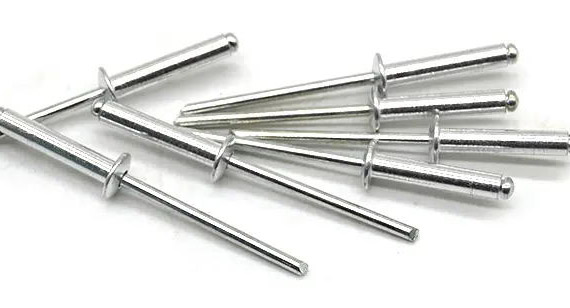
Hollow rivets: The structure is hollow inside and is suitable for connections that do not require high shear force, such as fixing materials such as plastic, leather, and wood.
Tubular rivets: Similar to hollow rivets, but mostly used for non-load-bearing riveting between non-metallic materials, suitable for lightweight and cost-effective solutions.
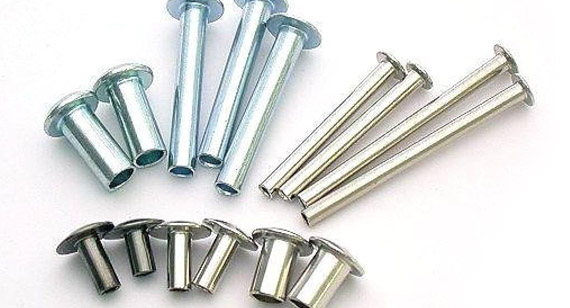
Materials Used for Rivets.
There are many kinds of materials used for rivets. The following are some commonly used materials for rivets:
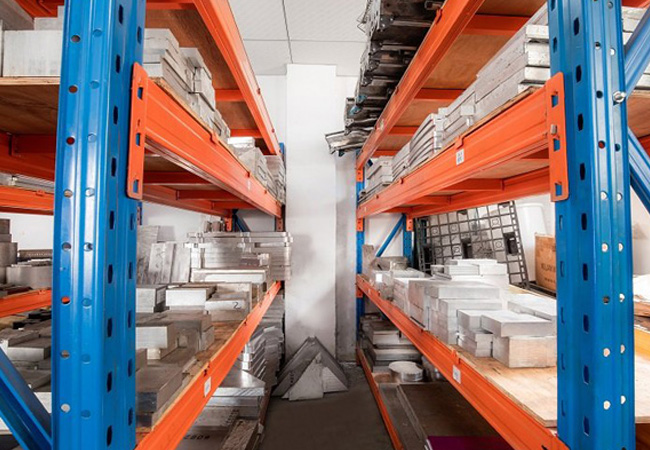
Aluminum: Aluminum alloy rivets are the most common type, with good corrosion resistance and lightweight, suitable for a variety of environments.
Stainless steel: Stainless steel rivets have high corrosion resistance and strength, and are particularly suitable for occasions where they need to be exposed to humid or corrosive environments for a long time.
Iron: Iron rivets are low-cost, but have relatively poor corrosion resistance and are mostly used for general connection needs.
Brass and copper: Rivets made from these materials have a unique appearance and performance, suitable for applications requiring aesthetics and a certain degree of corrosion resistance.
Carbon steel: Carbon steel rivets are subjected to surface treatments such as galvanizing to improve their corrosion resistance and aesthetics, and are widely used in various fields.
Nylon: Nylon rivets, also known as plastic rivets, are made of nylon material. Nylon material has good elasticity and memory properties, which enables nylon rivets to fit tightly during the connection process and can be assembled without additional tools. In addition, nylon rivets also have the advantages of insulation, corrosion resistance and lightweight, which are particularly suitable for the connection of electronic equipment and lightweight materials.
Advantages and Disadvantages of Using Rivets.
Riveting is a traditional yet highly reliable method of mechanical fastening widely used in aerospace, bridge construction, and heavy machinery manufacturing. While rivet joints provide excellent strength and durability, they also come with certain limitations in terms of installation complexity and material usage. The following is summarizes the main advantages and disadvantages of using rivets in structural connections:
| Category | Aspect | Description | Application/Impact |
|---|---|---|---|
| Advantages | High Strength | Riveted joints are tightly fixed, providing high load-bearing capacity and excellent resistance to vibration and fatigue. | Ideal for structures under high stress or dynamic loads, such as aircraft, bridges, and heavy machinery. |
| Reliable Connection | The mechanical nature of rivet fastening allows easy inspection and maintenance, ensuring connection quality and reliability. | Enhances overall safety and simplifies detection of potential joint failures. | |
| Lightweight | Rivet joints often achieve strong connections with less material compared to welding. | Helps reduce structural weight, especially important in aerospace and automotive sectors. | |
| Disadvantages | Complex Construction | Installation requires precise control of rivet length, diameter, and angle, making the process more difficult and costly. | Increases labor cost and time during assembly, particularly for large or complex components. |
| High Material Usage | A significant number of rivets are needed to ensure strength and reliability. | Leads to higher material consumption and structural weight. | |
| Limited Firmness in Extreme Conditions | Rivets may loosen or fail under severe vibration or stress if not properly designed. | Requires preventive measures and careful design to maintain long-term durability. |
What is Riveting?
Before understanding the willow grafting technique, you need to first understand what willow grafting is?
Rivet connection is a simple mechanical connection method. It uses a metal rivet with a diameter slightly smaller than the prefabricated hole to pass the rivet through the hole of the part to be connected. Then, by applying pressure or knocking on both ends of the rivet, the rivet is partially expanded and deformed in the hole, thereby forming a rivet head at both ends. In this way, the rivet is firmly fixed in the hole, connecting multiple parts tightly together.
Willow Grafting Technology and Characteristics.
Riveting connection, as an important fastening technology, mainly includes various methods such as pull riveting, impact riveting and rotary riveting. Each method has its unique characteristics and application scenarios.
Pull Riveting:
Pull riveting is a cold riveting method driven by hand or compressed air. It uses special rivets and pneumatic riveting guns to apply force to the rivets and the connecting parts, causing them to undergo plastic deformation, thereby achieving fastening. A notable feature of pull riveting is the blind riveting function, which means that there is no need to perform a rivet operation on the reverse side of the connecting part, which is extremely convenient for reverse parts with complex structures or difficult to access.
Punch Riveting:
Punch riveting is a method of connecting parts by applying pressure to cause plastic deformation of the rivet or connecting material. This process belongs to the category of cold heading process, which does not require heat input, so it will not damage the coating on the surface of the material, nor will it produce welding spatter and deformation. The riveting process is fast and efficient, and the materials at the connection point are embedded in each other, forming a tight connection without burrs or burrs.
Span Riveting:
Spin riveting is a riveting method that gradually forms the rivet rod by applying local pressure and swinging it around the center. According to the different spin riveting paths, it can be divided into swing riveting and radial riveting. The swing riveting method is relatively simple, and the rivet head only swings and rolls in the circumferential direction; while the radial riveting method is more complicated, and the rivet head movement trajectory is plum blossom-shaped, moving in the circumferential direction and swinging and rolling in the radial direction.
In Conclusion
Rivets are essential fasteners used to join two or more materials, playing a vital role in modern manufacturing. With a wide variety of types and extensive applications, rivets are indispensable in industries ranging from aerospace to construction. As CNC machining technology continues to advance, both manufacturing precision and efficiency have significantly improved. Understanding different types of rivets and their riveting processes is crucial for optimizing production and enhancing operational efficiency. Contact us today for a free rivet quotation and professional technical support to help you choose the optimal solution for your application.
Frequently Asked Questions About Rivet Nails
What is the Difference Between Blind Rivets and Solid Rivets?
The main difference between blind rivets and solid rivets lies in their structure and purpose. Blind rivets are designed for single-sided installation and are usually composed of a rivet rod, a rivet sleeve and other parts. There is no need to push the rivet from the other side of the material, which is suitable for scenes where double-sided operation is difficult. Solid rivets are one-piece metal fasteners and are mostly used in situations that require higher load-bearing capacity and safety, such as heavy industrial applications.
Are Rivets Stronger than Screws?
The comparison of rivets and screws in terms of firmness is not a one-size-fits-all approach. Rivets achieve a firm connection through deformation and are suitable for applications that require high strength and non-detachable connections, such as in the aviation and automotive fields. Screws, on the other hand, are fixed by thread engagement, making them easy to install and remove, and suitable for a variety of occasions, but they may become loose in complex environments. Therefore, the choice of which connector to choose depends on factors such as specific needs, usage environment, and cost.



